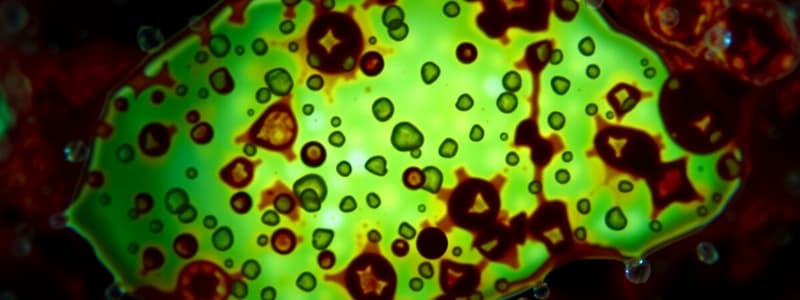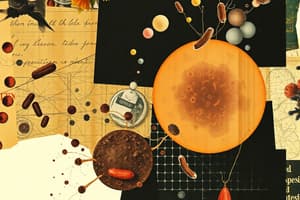Podcast
Questions and Answers
What is a key function of mitochondria in eukaryotic cells?
What is a key function of mitochondria in eukaryotic cells?
Which of the following correctly differentiates animal cells from plant cells?
Which of the following correctly differentiates animal cells from plant cells?
Which statement about unicellular organisms is true?
Which statement about unicellular organisms is true?
What defines organelles in eukaryotic cells?
What defines organelles in eukaryotic cells?
Signup and view all the answers
Which of the following best describes bacteria?
Which of the following best describes bacteria?
Signup and view all the answers
What is the primary role of mitochondria in eukaryotic cells?
What is the primary role of mitochondria in eukaryotic cells?
Signup and view all the answers
Which of the following statements correctly describes a key difference between unicellular and multicellular organisms?
Which of the following statements correctly describes a key difference between unicellular and multicellular organisms?
Signup and view all the answers
What is a defining characteristic of bacterial cells?
What is a defining characteristic of bacterial cells?
Signup and view all the answers
Which of the following options identifies an organelle present in both animal and plant cells?
Which of the following options identifies an organelle present in both animal and plant cells?
Signup and view all the answers
What is one function of guard cells in plants?
What is one function of guard cells in plants?
Signup and view all the answers
Study Notes
Cells
- Basic units of life; structural and functional entities
- Form tissues and organs; essential in all organisms
Microscopes
- Utilize an ocular lens; single-eyepiece microscopes are common
- Magnify small samples; widely used for cellular observation in basic studies
Mitochondria
- Energy-producing organelles found in eukaryotic cells
- Key sites for cellular respiration and ATP generation
Unicellular and Multicellular Organisms
- Unicellular: Single-celled organisms like bacteria and amoeba
- Multicellular: Organisms with multiple cells such as humans and plants
Animal vs. Plant Cells
- Animal cells lack a cell wall; plant cells possess chloroplasts
- Animal cells do not have a large vacuole, whereas plant cells do
- Both are classified as eukaryotic cells
Organelles
- Cellular structures performing specific functions
- Include nucleus, mitochondria, and are found in eukaryotic cells
- Work collaboratively to ensure cell survival
Organelles in Fungal Cells
- Contain nucleus and mitochondria; cell wall made of chitin
- Lack chloroplasts; have vacuoles for storage
White Blood Cells vs. Red Blood Cells
- White blood cells serve as immune defenders, combating infections
- Red blood cells transport oxygen, characterized by hemoglobin-rich, biconcave structure
Nerve Cells
- Neurons transmit signals; characterized by long, specialized structures
- Enable communication and response within the nervous system
Specialized Plant Cell Types
- Root cells are responsible for nutrient absorption
- Guard cells regulate gas exchange
- Xylem transports water; phloem transports sugars
Organelles in Animal Cells
- Key organelles include nucleus, mitochondria, ribosomes
- Additional structures: endoplasmic reticulum, Golgi apparatus, lysosomes, peroxisomes, vacuoles
- Surrounded by cytoplasm and plasma membrane
Living Things
- Organisms that engage in biological processes
- Growth and reproduction are essential; respond to environmental stimuli
- Include animals, plants, and microbes
Bacteria
- Unicellular prokaryotic organisms; lack membrane-bound organelles
- Exist in various environments; can be beneficial or harmful
Viruses
- Defined nature and characteristics not specified; require further detail for clarification
Cells
- Basic units of life; structural and functional entities
- Form tissues and organs; essential in all organisms
Microscopes
- Utilize an ocular lens; single-eyepiece microscopes are common
- Magnify small samples; widely used for cellular observation in basic studies
Mitochondria
- Energy-producing organelles found in eukaryotic cells
- Key sites for cellular respiration and ATP generation
Unicellular and Multicellular Organisms
- Unicellular: Single-celled organisms like bacteria and amoeba
- Multicellular: Organisms with multiple cells such as humans and plants
Animal vs. Plant Cells
- Animal cells lack a cell wall; plant cells possess chloroplasts
- Animal cells do not have a large vacuole, whereas plant cells do
- Both are classified as eukaryotic cells
Organelles
- Cellular structures performing specific functions
- Include nucleus, mitochondria, and are found in eukaryotic cells
- Work collaboratively to ensure cell survival
Organelles in Fungal Cells
- Contain nucleus and mitochondria; cell wall made of chitin
- Lack chloroplasts; have vacuoles for storage
White Blood Cells vs. Red Blood Cells
- White blood cells serve as immune defenders, combating infections
- Red blood cells transport oxygen, characterized by hemoglobin-rich, biconcave structure
Nerve Cells
- Neurons transmit signals; characterized by long, specialized structures
- Enable communication and response within the nervous system
Specialized Plant Cell Types
- Root cells are responsible for nutrient absorption
- Guard cells regulate gas exchange
- Xylem transports water; phloem transports sugars
Organelles in Animal Cells
- Key organelles include nucleus, mitochondria, ribosomes
- Additional structures: endoplasmic reticulum, Golgi apparatus, lysosomes, peroxisomes, vacuoles
- Surrounded by cytoplasm and plasma membrane
Living Things
- Organisms that engage in biological processes
- Growth and reproduction are essential; respond to environmental stimuli
- Include animals, plants, and microbes
Bacteria
- Unicellular prokaryotic organisms; lack membrane-bound organelles
- Exist in various environments; can be beneficial or harmful
Viruses
- Defined nature and characteristics not specified; require further detail for clarification
Studying That Suits You
Use AI to generate personalized quizzes and flashcards to suit your learning preferences.
Description
This quiz explores the fundamental concepts of cells as the basic units of life, including their structure and function. It also covers the role of microscopes in cellular observation and the significance of organelles like mitochondria in energy production. Understand unicellular and multicellular organisms with examples.




